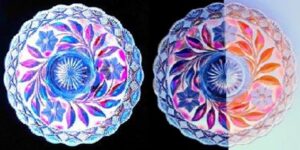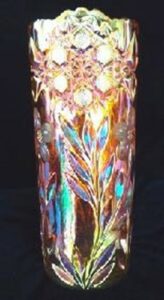The Dilemma of the Dahlia
By Kate Lavelle
I know that over the years I’ve written many articles encouraging you all to go out and about and see what may be sitting around gathering dust in various places and yep, here’s another. The hunt can certainly be done from the cozy confines of your own home via eBay and other sites. We do that too, but it’s really such a great time going out on the prowl. And every once in a while, with a little bit of good luck, we dedicated carnival glass hunters run into something that’s just a little bit different than the run of the mill pieces that one usually finds at so many locations.
My husband Bill and I truly enjoy taking day trips around southern Wisconsin and northern Illinois in search of new items to either add to our collection or to resell to other collectors. Like many of you, while having fun traveling hither and yon, we’ve accomplished a multitude of upgrades and in a few cases, found one-of-a-kind pieces or previously unknown colors of known patterns. For example, on previous excursions we were ecstatic and quite lucky to locate the only known Cristalerias Rigoleau CR ashtray in vaseline and the only known Enameled Aster pitcher. Seek and ye shall find.
The lovely and unusual plate that is featured in this article was an unknown, at least to us, as we had never encountered this pattern before. It was discovered last April at a monthly county antique fair. This location is quite a huge venue, with dealers indoors and out and provides us with a great deal of exercise and amusement each time we attend. The day of this particular excursion was a good one as we found a few decent pieces on this trip. I was already quite pleased to score an upgrade of my aqua Fenton Acorns bowl and found a really dandy marigold Stag & Holly large ICS bowl to resell as well. Having done so, by this point it had already not been a waste of time and effort. We had just about completed the adventure when we visited the booth of a dealer who sometimes had what we deemed to be neat items. He’s not a glass dealer; just sells a little bit of everything. While slowly strolling through his always cluttered booth I glimpsed a faint glimmer of iridescence from beneath a few uniridized plates, lifted the others off and happily uncovered this large and beautiful marigold chop plate.
Bill and I both found it to be quite charming and esthetically appealing, even though we were totally clueless as to what it was. Additionally, considering the reasonable $10 price it was an easy decision to take it home with us to try and figure out later. We’ve been collecting carnival glass for a very long time now, yet still run into items occasionally that stump us. Probably like you, we actually consider it to be fun doing the research, so we figured with a little time and effort online and/or through our books we’d figure it out soon enough. Wrong.
On right you see the beautiful plate that shows the Dahlia pattern. On the left for this striking photo, Kate placed the plate showing half on a black background and half on white.
After spending over four solid hours researching, with no answers whatsoever, I gave up, threw in the towel and texted my tale of woe and some pictures to my usual “go to guy”, dearest friend, Lane Booker. He knows more about glass than I ever will. Because he is a walking, talking, carnival glass encyclopedia, it’s nearly an impossible task to find a pattern that he doesn’t know. I told him that I was exhausted, admitted defeat and surrendered to his much more knowledgeable mind. I have only stumped the dude once, he’s that good. His reply this time was, “I’ve never seen one! I have no idea, other than U.S. Glass made similar patterns. Barb Chamberlain would be someone to ask.”
Needless to say, that was my back up plan, so I was in total agreement. Having enjoyed a delightful friendship with Barb for many years now, I took my query to her next via email. I agreed that Lane was likely on the right track about it possibly being a U.S. Glass product, and then I heard back from Barb. She replied “I will check my books – it could be U.S. Glass or McKee Glass or another one. Both U.S. and McKee made patterns like this, so I will see what I can find and get back to you.” Later that evening I heard back from her, “I think I have identified your plate. I believe it is Jenkins Dahlia No. 286.” and she sent me the scan you can see here of the Jenkins plate and other Dahlia items. The sketches are from the Just Jenkins book by Joyce Hicks. The sketches are rough, but still there was no doubt the plate was the Dahlia pattern.
Here is the catalog page of Jenkins’ Dahlia No. 286 from the Just Jenkins book by Joyce Hicks.
However, there was one glaringly obvious difference…the edge. In looking at various photos of the Jenkins Dahlia pattern it was apparent that the edge design did not match the Jenkins version, so the mystery deepened.
Note the edge on the Jenkin’s Dahlia compote matches the edge in the catalog. Photo by Seeck’s Auction.
Furthermore, according to a National Depression Glass Association article from 1972 by Sandy Stout Olander, Jenkins did not iridize their marigold glass products. Quoting directly from her article, “The Jenkins Glass Company issued patterns in pink, green, crystal and iridescent marigold. Marigold was the only iridescent color issued and was not done at the Jenkins plant; however, the blanks were made there and decorated elsewhere, then brought back to the Jenkins plant.” This cast further doubt in my mind that Jenkins had made this particular Dahlia plate.
In an article on Diane Fry’s Carnival Glass 101 website entitled Jenkins and U.S. Glass (that can be seen at http:// www.carnivalheaven.com/ carnivalglass107/id54.htm ) there are several photos of Dahlia pieces including a very large bowl in marigold. The edge pattern on this bowl is exactly the same as our mystery plate and Diane had called this bowl’s pattern Diamond and Daisy Cut Variant. She stated that when the Jenkins factory was sold to U. S. Glass the moulds for the original pattern may have been sold to them as well. She speculated that the original mould had perhaps been reworked by U.S.Glass with a new edge pattern as in the bowl displayed on her site and with our large plate. A large marigold bowl is also pictured in Mike Carwile’s 12th edition of the Standard Encyclopedia of Carnival Glass and is listed as Diamond and Daisy Cut Variant. He credits Jenkins as the manufacturer. However, it also has the same edge as our plate. At the time that his book was published in 2010 he reported that this bowl was the only reported example. He referred to it as a punch bowl, however no base or cups are known to exist, and he valued it at $625 at that time.
Jenkins began production of the Dahlia pattern in 1903 and it proved to be a popular one for them with 21 separate items offered in this pattern, including an 11” plate, during their many years of production. However, none of their items carry the unusual edge that the bowl or our plate displays.
The Lavelle’s Dahlia plate is seen above. Note that the edge is similar to the Cut Cosmos edge.
This delightful plate measures 11” in diameter. The iridescence, mould details and wheel cutting are all on the exterior of the plate. It carries three hand done wheel cut six petaled blossoms with the dimpled centers and petal separations being part of the mould. These are featured between three sprays of foliage, two of seven leaves and one of eight, that are also part of the mould. The 3 5/8” marie features a 24-point star with every other ray being elongated. The edge design consists of an inward facing seven-point fan, a patterned diamond followed by another seven-point fan facing outwards within each scallop along the outer edge. The two fans and the diamond shape are all separated by a framework outline that is also part of the mould. The central depression on top of the plate would hold an item 3 ¼” in diameter. It’s a hefty plate as well, weighing in at a whopping two pounds, five ounces.
The U.S. Glass Cut Flowers vase is shown above.
I don’t have many U.S. Glass products in my collection, but one of my favorite marigold vases is Cut Flowers. I purchased the beauty pictured here from Tom Mordini a few years ago and I just adore it. The Cut Flowers vase was also long thought to be a Jenkins product until research proved it to actually be by U.S. Glass. When comparing the two pieces together it is easy to observe that there are several commonalities that strongly suggest that they were both possibly made by the same manufacturer. The iridescence is of similar quality, the pieces are both heavy and thick glass, the foliage on both pieces is virtually identical and both include meticulous hand done wheel cut etching of the blossoms on both patterns. They certainly do look like “kissing cousins” to me, but again, this is only my assumption. I offer photos here of both patterns and strongly feel that it’s not too much of a stretch of the imagination to opine that both of them are U.S. Glass products.
The wheel cut Dahlia flower appears on the left, while the Cut Cosmos flower is to the right.
My purpose in writing this article is to assist other collectors who may come upon one of these beauties some cine day and know that they have a Dahlia piece, but not necessarily the one produced by Jenkins. Since there are now two known examples of this variant, it’s certainly more than quite likely that there are more out there. Perhaps you will be the next collector to come upon one of these beauties and now you will know that there is the Jenkins pattern and also this obscure variant.
I would like to kindly thank Lane Booker and Barb Chamberlain for their help in trying to solve the mystery of our lovely Dahlia plate, which could perhaps be called the Diamond and Daisy Cut Variant plate. In my humble opinion, Dahlia Variant would be my suggestion for a pattern title, as it is so obviously inspired by the original Jenkins product, yet is clearly a variant. Happy hunting wishes from both of us to one and all!
Most photos courtesy of Kate Lavelle
This article first appeared in the ICGA Pump in the December 2018 issue and is reprinted with permission.






